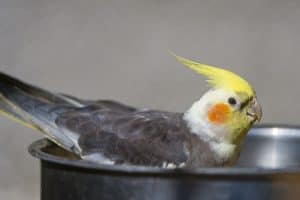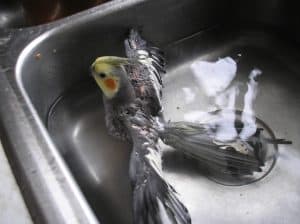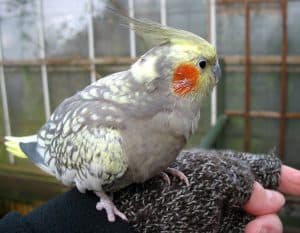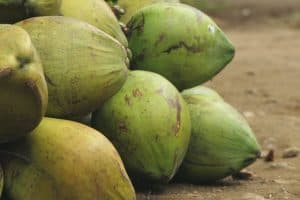Cockatiels are beautiful and intelligent pet birds, known for their friendly and affectionate nature. As pet owners, we always strive to ensure the good health and happiness of our feathered friends. One aspect of keeping our pet birds in good shape is providing them with fresh water for drinking and bathing. In this blog post, we will explore the relationship between cockatiels and water, their natural ability (or lack thereof) to swim, and how to safely introduce water to your pet cockatiel for their enjoyment and good health.
Can cockatiels swim? (Cockatiels and Water)
Cockatiels, like other birds, need clean water for drinking and regular bathing. In the wild, these parrots come from Australia’s arid and semi-arid regions, where water sources may be scarce. Despite this, they still manage to find water and enjoy taking showers or baths to keep their feathers clean and free of feather dust.
Regular bathing is essential for cockatiels as it helps maintain the health of their feathers, encourages the growth of new feathers, and reduces the amount of feather dust in their environment.

To understand this, we need to look at the physical adaptations of cockatiels and other birds that might enable them to swim.
1. Feathers and water repellency: Birds’ feathers, especially those on their wings, have a certain degree of water repellency. This is essential for birds that live in wet environments or enjoy taking showers, as it helps them stay warm and dry. However, this water repellency is not enough to enable them to float or swim in deep water.
2. Leg and foot structure: Unlike waterfowl, such as ducks and geese, which have webbed feet and strong legs adapted for swimming, cockatiels and parrots do not have these features. Their legs and feet are designed for perching and climbing rather than swimming.
In instances where cockatiels and parrots are found in water, it is often accidental, such as when a bird falls into a swimming pool, a bath, or another body of water. In these situations, they may be able to paddle in shallow water to some extent, but they do not have the natural ability to swim like waterfowl.
The limitations and dangers of swimming for cockatiels
Given their lack of natural swimming ability, there are several risks and dangers associated with cockatiels and water:
1. Risk of drowning: As cockatiels and parrots cannot swim or float effectively, they can easily become overwhelmed in deep water and drown.
2. Hypothermia and other health risks: If a cockatiel becomes wet and is exposed to cold temperatures for an extended period, they can suffer from hypothermia or other health issues.
Safe Water Interactions for Cockatiels

Despite their inability to swim, cockatiels can still enjoy water in a controlled and safe environment. Here are some tips for providing a proper bathing environment for your pet bird:
1. Shallow water dishes: Provide a shallow dish or bowl with clean water inside your bird’s cage, allowing them to splash and bathe at their leisure. This will also help them stay clean and maintain the health of their feathers.
2. Bird baths and misting: Another option for bathing your cockatiel is to use a bird bath designed for pet birds or a spray bottle to create a light mist over your bird. Be sure to use warm water and avoid spraying directly into their eyes or ears.
3. Supervised and controlled interaction with water: For those with a shower perch, you can introduce your cockatiel to the shower by placing them on the perch and using a gentle shower head or spray bottle to create a light mist around them. Be sure to monitor your bird closely for any signs of distress or discomfort.
Keeping Your Cockatiel Safe Around Water
It is crucial to keep a close eye on your feathered friend when they are around water. Look out for signs of distress, such as heavy breathing, fluffed-up feathers, or fear. If you notice any of these signs, remove your bird from the water as soon as possible and move them to a warm room.
It’s also essential to select the right bathing method for your cockatiel. For example, some birds may prefer a shallow dish, while others may enjoy the shower perch or a light mist from a spray bottle. Experiment with different methods to find the one that works best for your pet.
How often should you take your cockatiel for a swim?

There is no set frequency for taking your cockatiel swimming; it can be done as often or as little as you like. If you do decide to take your cockatiel swimming on a regular basis, you may want to consider using a kiddie pool or other shallow body of water specifically for this purpose. This will help to avoid accidental drownings and will make it easier to supervise your cockatiel while it is swimming.
Cockatiel owners who live in warm climates may find that their cockatiels enjoy taking a dip in the pool on hot days. If you have a swimming pool, you can provide your cockatiel with a little relief from the heat by placing a kiddie pool or other shallow container of water in the shade for it to splash around in.
Having a regular bathing routine for your cockatiel will also help reduce feather dust and keep its feather clean and healthy. Just be sure to empty and refill the pool with clean water daily and never leave your cockatiel unattended while it is swimming.
Parrots swim for the same reason that they bathe; to clean and preen their feathers. A daily bath is necessary for good feather health, but since most cockatiels do not live in humid climates, they may need help staying hydrated. Swimming is a great way to help your cockatiel stay hydrated and can also be a fun way for you to bond with your feathered friend.
Final Thoughts
Cockatiels are social creatures and enjoy spending time with their human companions. Swimming is a great way to bond with your cockatiel and provide it with some much-needed exercise. Just be sure to always supervise your cockatiel when it is near water and never leave it unattended. With a little patience and positive reinforcement, you can teach your cockatiel to enjoy swimming as much as you do.




